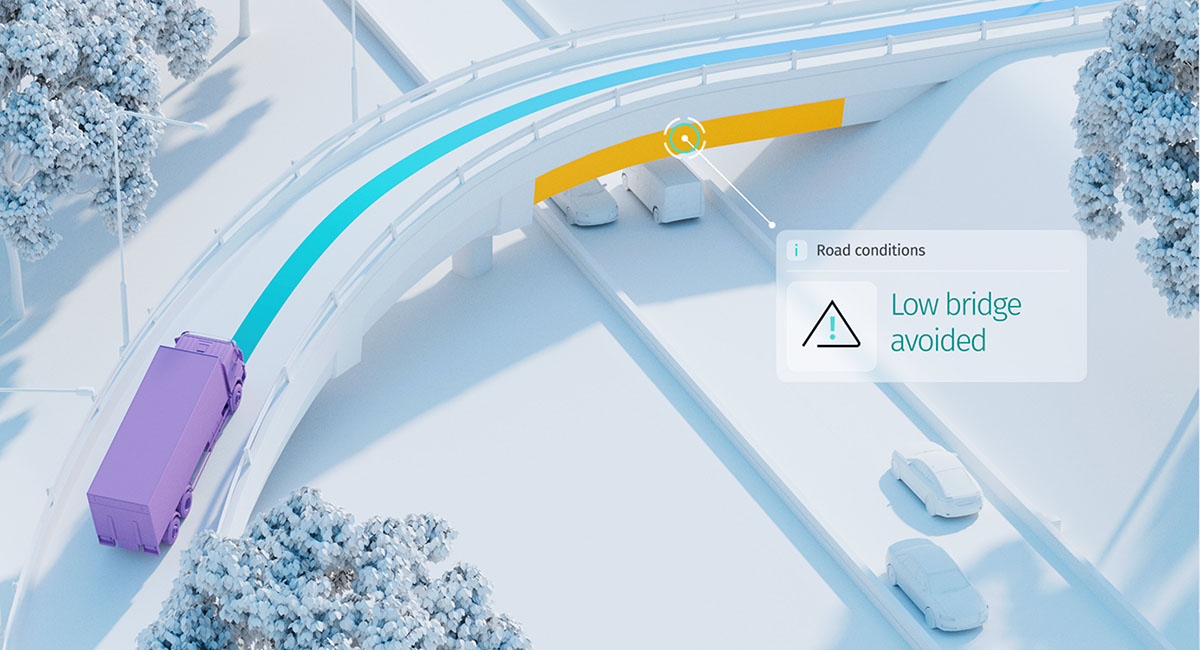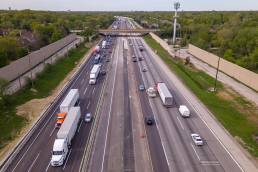Truck navigation GPS: Making sure it’s right for your drivers and your customers
Transportation and logistics are essential to a fully functioning economy. According to the Transportation Statistics Annual Report 2022, 38% of the US’s gross output relied upon the sector in 2020. Perhaps less well-known is the significant role that trucking plays as part of this.
Looking at data from 2019, trucks were responsible for moving approximately 12 billion tons or 67% of total domestic freight volume, about 10 times more than that of rail, the third-highest ranked mode of transport by freight volume in the US. Reliable truck navigation is essential, therefore, if food, medicine, and other goods are to arrive at their destination.
However, all too often, freight vehicles employ location solutions that aren’t specifically designed for trucking. This means drivers could be told to follow a route that isn’t suitable for their vehicle, potentially resulting in delays, damages, financial repercussions or personal injury. But there are solutions on the market that are optimized for truck routing and we’ll explain some of the features you can expect to find when you employ them.
What to look for in your truck routing
When looking at different truck routing applications, it’s important to consider the different attributes that make these vehicles unique. In terms of height, weight, and types of cargo, there may be certain reasons why some routes are not viable. There may also be regulatory factors to consider that apply to both the driver and the vehicle.
Dedicated truck navigation solutions should allow drivers or fleet managers to factor the truck’s attributes into any route. Physical restrictions like low bridges or tight corners can be avoided as can any routes that contravene regulatory standards. Driving a truck is not the same as driving a car – and navigation tools should reflect that.
It’s also true that even within truck routing, standards can vary markedly. For instance, there is a substantial height difference between “regular” and “tall” delivery vans in the US, with the former being up to 8ft 11in high while the latter could be 13ft 6in high. If a navigation app doesn’t factor this difference into its route planning, the driver could end up missing their delivery window or subjecting themselves to an unnecessarily dangerous route. The most direct route for one truck may not be feasible for another.
Of course, there are other features that are important for truck navigation. One of these is the ability to include a large number of waypoint stops along any route. Truck drivers are often tasked with transporting their cargo over extremely long distances, so including regular stops is essential for safe transportation.
And as with any type of location solution, regardless of the type of vehicle being used, access to real-time data is key. Incident-aware routing is necessary to inform truck drivers of exceptional traffic levels, planned construction or other changes that are relevant to the chosen route. As with cars, trucks need to be able to alter their course based on new developments in real time.
Tailored to your entire fleet
Ensuring your truck navigation is working well for a single vehicle is great for a particular driver but in most instances, those drivers are likely to be part of a larger fleet. As such, it is hugely important that truck navigation tools include features that are relevant to logistics firms with multiple vehicles. As such, it is a good idea to use a solution that includes fleet management capabilities.
First of all, organizations must ensure that their chosen application supports several truck routing options. Sometimes your truck drivers may need the fastest route, while at other times they may want to avoid a certain type of road. The important thing is that truck drivers and fleet managers have options available to them.
As well as supporting several route options, truck navigation tools should be customizable. This allows fleet managers to optimize their tour planning for cost or time, incorporating fleet size, vehicle types and loading capacity across all vehicles. They can calculate and dispatch thousands of deliveries across their fleet within a working shift by sending a single request. Look for a level of personalization that ensures each route is tailored to the specific requirements of each truck.
In addition to the features on offer, think carefully about how your truck routing solution fits in with your existing technologies. Look for navigation tools that offer smooth and straightforward integration. Working closely with fleet management systems improves communication between drivers and dispatchers, streamlining operations, reducing downtime and allowing you to get to market quicker.
A solution truck drivers can trust
As well as the vehicles themselves, truck navigation solutions must consider driver needs too. That’s something that HERE’s Truck Routing takes into consideration. With HERE, it’s easy to dynamically update routes in real-time, providing drivers with updated ETAs so they remain informed and your customers are kept aware of the latest developments.
When routes aren’t optimized for trucks, it’s not just customers who end up annoyed about delayed deliveries either. Drivers can become frustrated too. By using HERE’s Truck Navigation, it’s not only possible to find the most appropriate route but also to lower costs per delivery and improve driver satisfaction levels. In fact, HERE provides a potential 20% increase in driver productivity meaning you can maximize your fleet utilization and the skills of your truck drivers.
This is because one of the other primary benefits of HERE’s solutions is the added insights they provide for fleet managers. With HERE Tour Planning, for example, it’s possible to assign the right jobs to the right drivers based on a number of factors including the cargo, driver experience, and more. Truck routing should have access to the same granularity of real-time data as travel by car. With HERE, that’s the case.
More than just a reseller, working with Local Eyes can take your truck routing to the next level. At Local Eyes, the data and expertise that HERE has acquired over decades is accompanied by our world-class support. For truck drivers and fleet managers, this means they are supplied with automatic updates, real-time status alerts, and support whenever they need it.
Get in touch with us to see why a bespoke truck navigation tool is the solution that your drivers and their customers deserve.
Local Eyes B.V. is a leading reseller and integrator of geospatial technologies and data that has been contributing to its client’s success for the past 10 years by optimizing their decision-making and logistic processes. If you’re interested in learning more about how Local Eyes can provide you with truck navigation GPS, get in touch today.






